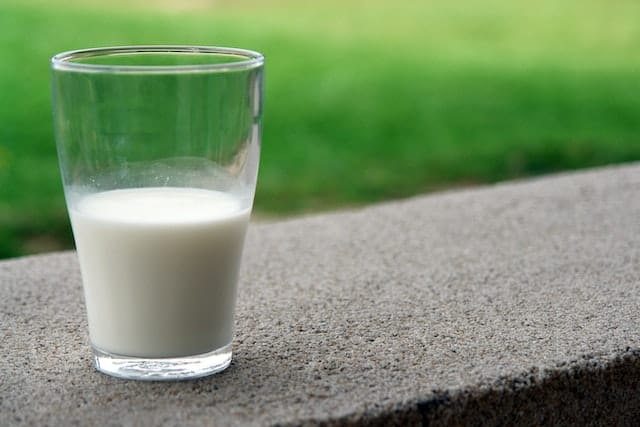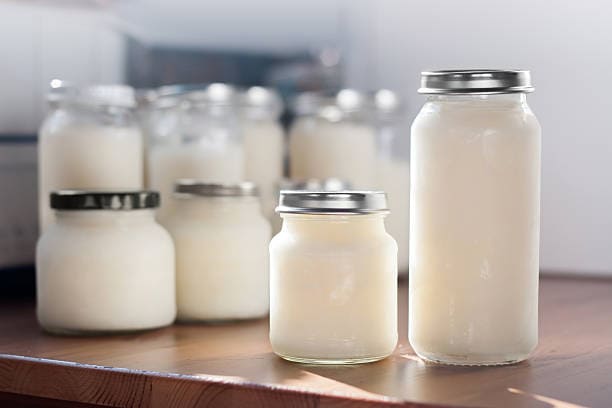Freezing raw milk has been a topic of discussion among dairy enthusiasts and health-conscious individuals alike. Raw milk, as opposed to pasteurized milk, contains many beneficial nutrients and enzymes straight from the cow, which may be the reason for some people’s preference.
However, unlike pasteurized milk, raw milk has a much shorter shelf life. This has led many to wonder about the possibility of freezing raw milk to extend its usability.
There’s no denying that freezing can be a convenient method of preserving various food items, but is it suitable for raw milk? Along with exploring the possible impacts on taste, texture, and nutritional value, understanding the proper methods of freezing and thawing raw milk is essential.
Additionally, it’s crucial to consider the safety concerns and health benefits associated with consuming frozen raw milk.
Key Takeaways
- Freezing is a method to extend the shelf life of raw milk, but it’s essential to understand taste, texture, and nutritional impacts.
- Proper freezing and thawing techniques, along with suitable containers, can help preserve raw milk’s quality.
- Be aware of the safety concerns and health benefits associated with consuming frozen raw milk, especially compared to pasteurized milk.
Understanding Raw Milk

Raw milk is the unprocessed and unpasteurized milk obtained directly from cows, goats, or other milk-producing animals. It is a highly nutritious and natural dairy product, containing essential vitamins, minerals, and enzymes.
Raw goat milk and other raw dairy products are increasingly popular among consumers who appreciate their nutritional benefits, distinctive taste, and some of their properties that aid in digestion.
The digestibility of raw milk is often attributed to its lactose and protein content. Lactose is a natural sugar found in dairy milk, and some people find it easier to digest in its raw form.
Additionally, the proteins in raw milk are structured differently than those in pasteurized milk, which may contribute to its easier digestion for some individuals.
One of the main concerns with raw milk is bacterial growth. Since it is not subjected to pasteurization, harmful bacteria such as Salmonella, E. coli, and Listeria can thrive in the milk. Bacterial content in raw milk can vary, depending on factors such as animal health, milking conditions, and storage methods.
It is crucial for consumers to be cautious and informed when consuming raw milk or raw dairy products to minimize health risks associated with bacterial contamination.
In conclusion, raw milk offers unique nutritional benefits and a distinct flavor profile, making it a desirable option for those who prefer its taste and properties. However, it is essential to be informed about potential risks and ensure proper storage and handling to avoid bacterial contamination and potential health issues.
Raw Milk and Freezing
Freezing raw milk is certainly possible and can be a useful method for preserving its freshness. When raw milk is frozen, the formation of ice crystals will occur, which will expand and cause the milk to solidify.
The expansion of the ice crystals may change the texture and appearance of the milk, but it is still safe to consume and can retain many of its original nutrients.
To freeze raw milk, it is important to use proper techniques to minimize any potential loss of quality. Firstly, be sure to leave some room for expansion in the container, as the milk will increase in volume when frozen.
To prevent freezer burn, using airtight containers or vacuum-sealed bags is recommended. Additionally, it is essential to store the raw milk at a consistent temperature in the freezer, ideally around 0°F (-18°C) or colder.
When thawing frozen raw milk, there are a few methods that can help ensure the best possible outcome. Slowly defrosting the milk in the refrigerator over 24 hours can help minimize the formation of ice crystals and maintain its original texture.
Alternatively, if a quicker thawing method is desired, placing the container in a water bath maintains an even temperature and prevents the milk from getting too warm.
It is important to note that the freezing and thawing process may separate the fat content in raw milk which can result in some structural changes. Gently shaking the milk after thawing can help redistribute the fat and bring the milk back to its original consistency.
In conclusion, freezing raw milk is a viable method for preserving its freshness, while still retaining most of its nutrients and overall quality. Employing the proper techniques for freezing and thawing can make a significant difference in ensuring the best outcome when using frozen raw milk.
Choosing the Right Containers

When it comes to freezing raw milk, selecting the appropriate container is crucial. Using freezer-safe containers ensures that the milk will maintain its quality and safety throughout the freezing process.
There are various container options available, including glass jars, plastic jugs, plastic containers, and freezer bags such as plastic freezer bags and Ziplock bags.
Glass jars are a popular choice for freezing raw milk as they are reusable and environmentally friendly. It is important to choose jars that are freezer-safe to prevent breaking due to the expansion of milk when frozen.
Additionally, leave about an inch of headspace at the top of the jar to accommodate this expansion. However, take note that glass jars may be more fragile than other options and require extra care when handling.
Plastic jugs, on the other hand, are lightweight and durable, making them a practical choice for freezing raw milk. These jugs often come with tamper-evident lids which secure the milk and help prevent contamination.
However, not all plastic jugs are freezer-safe, so be sure to check the label or manufacturer’s recommendations before using them for freezing purposes.
Similarly, plastic containers can be a suitable option for freezing raw milk, especially if they are specifically designed for freezer use. These containers generally have tight-fitting lids that seal in freshness and prevent potential spills. Just like with plastic jugs, verify that the plastic containers are indeed freezer-safe.
Another alternative is using freezer bags such as plastic freezer bags and Ziplock bags. These bags are convenient, space-saving, and specifically designed for freezer storage.
Ensure that the bag is filled and sealed correctly to avoid leaking and exposing the milk to possible freezer odors. Before sealing, try to remove as much air as possible from the bag, and then securely close it.
In conclusion, selecting the right container for freezing raw milk greatly depends on individual preferences and needs. Consider factors such as durability, reusability, space requirements, and freezer compatibility when choosing your ideal container.
Steps to Freeze Raw Milk
Freezing raw milk is a practical way to preserve its freshness and extend its shelf life.
Following these steps will help ensure the milk retains its quality and is safe to consume after thawing.
1. Prepare the raw milk: Before freezing, make sure the raw milk is fresh and has been properly stored. It should be free of contaminations, and its temperature should be at 40°F or below.
2. Choose the right container: Use freezer-safe containers or bags to store the milk. Freezer bags are a favorable choice as they can be easily labeled and are less prone to leaks. Leave a little space at the top of the container or bag to allow for expansion of the milk when it is frozen.
3. Label the container: Clearly label the milk container with the date of freezing and any other relevant information. This will make it easy to identify the milk and keep track of its freezing duration, ensuring it is consumed within a suitable timeframe.
- Freezing duration: Raw milk can be stored in the freezer for up to 3 months without significant loss of quality.
4. Place in the freezer: Arrange the milk containers or bags in a way that allows for proper air circulation inside the freezer. The temperature of the freezer should be at 0°F or below for optimal results.
5. Thaw properly when needed: To thaw frozen raw milk, transfer it to the refrigerator and let it defrost slowly. This process may take several hours or overnight, depending on the container and volume of milk. Avoid using a microwave or placing the milk in warm water as it might compromise the quality.
Remember that freezing raw milk does not kill any bacteria that might be present when it was initially frozen. Once thawed, handle the milk carefully and consume it within a few days to avoid spoilage.
The Impact on Taste and Texture

When raw milk is frozen, it undergoes a few changes that can impact its taste and texture. One of the primary concerns with freezing raw milk is the separation of fat from the milk.
As milk freezes, ice crystals form and the fat particles can clump together, leading to separation. This can result in a slightly altered texture when it’s thawed.
Thawed raw milk can have a less smooth consistency compared to its original pre-freeze state. When the milk is thawed, the ice crystals melt, and the fat particles may not be evenly distributed throughout the liquid.
The separation of fat may also affect the mouthfeel and creaminess of the milk. Some people may feel that it is less desirable due to this change.
Despite these changes in texture, the taste of raw milk can retain much of its original flavor after freezing. However, there may be subtle differences in the taste profiles due to the separation of fat. This may make the thawed milk taste slightly different than its fresh counterpart.
Thawing Raw Milk
Thawing raw milk is a simple process that requires some attention to detail to achieve the best results. The goal is to preserve the milk’s natural properties and nutritional value. To thaw raw milk, follow these steps:
- Transfer milk from the freezer to the refrigerator: The ideal method to thaw raw milk is in the refrigerator. This is a gradual process which helps prevent bacterial growth. Place the container of frozen milk on a shallow dish or tray in the refrigerator to catch any condensation or drips.
- Time to thaw: Depending on the container size, thawing raw milk in the refrigerator can take around 24 to 48 hours. It is essential to plan accordingly to ensure the milk is thawed when needed.
- Avoid using a microwave or direct heat: Thawing raw milk using a microwave or direct heat source is not recommended. These methods may cause uneven thawing and compromise the quality of the milk
- Gentle agitation: Raw milk may separate into cream and milk during thawing. To recombine them, gently shake or stir the milk container once it has thawed. Be cautious not to introduce any contaminants during this process.
- Inspect the milk: After thawing, inspect the raw milk for any off smells or changes in appearance. If it seems spoiled, discard it as a precaution.
- Consume promptly: Once thawed, raw milk should be consumed within a few days to a week, depending on the freshness at the time of freezing. Keep it refrigerated and tightly sealed when not in use.
By following these steps, you can successfully thaw raw milk while maintaining its quality and taste.
Using Frozen Raw Milk
Freezing raw milk is a practical method for preserving its freshness and nutritional value. When using frozen raw milk for cooking and baking, defrost it in the refrigerator for a day or two to retain its original properties.
Gently shake the container to mix the fat and liquid components for a consistent texture.
Frozen raw milk is suitable for a variety of recipes, such as oat milk, soy milk, almond milk, and coconut milk alternatives. It also works well for smoothies when blended in a high-quality blender, providing a rich and creamy taste.
For best results, use partially defrosted raw milk as it blends without diluting the frozen fruit and other ingredients.
Incorporating frozen raw milk in recipes that call for cream, cheese, or yogurt is an excellent option. When making cream, simply blend the defrosted milk with a high-fat content ingredient like coconut oil or avocado.
For cheese and yogurt recipes, follow the same process of defrosting and ensure the use of the right bacterial cultures or acidic agents for the desired end product.
It’s essential to note that pasteurized milk and fresh milk might yield different results due to the varying heat treatment processes. Pasteurized milk undergoes heating to eliminate bacteria, which might alter the proteins and fats, while fresh milk maintains its raw, unaltered state.
When using frozen raw milk, consider its distinctive characteristics and adjust recipes accordingly.
Remember to maintain a confident, knowledgeable, neutral, and clear tone when sharing information on using frozen raw milk in various culinary applications.
Discussing the versatility of frozen raw milk in a third-person perspective while using the English language assures readers of its suitability in an array of dishes.
Safety Concerns and Health Benefits
Raw milk, as the name suggests, is milk that has not undergone pasteurization, which is a process that involves heating the product to a specific temperature for a set period to eliminate pathogens. Due to the absence of this treatment, there are a few safety concerns tied to consuming raw milk.
However, proponents of raw milk argue that it offers some health benefits that may not be present in pasteurized milk. Raw milk is often rich in conjugated linoleic acid (CLA), an essential fatty acid known for its potential benefits on heart health and weight management.
Additionally, some studies suggest that raw milk consumption may aid in enhancing the immune system and reducing asthma and allergy symptoms.
While pasteurization does help reduce the risk of consuming harmful bacteria, it can also diminish the nutritional value of milk. Pasteurized dairy products may have lower levels of heat-sensitive vitamins such as vitamin C and B-complex vitamins.
Furthermore, the process might potentially destroy some of the milk’s beneficial enzymes and bacteria.
Despite the possible health benefits, it is essential to exercise caution when consuming raw milk, as it can pose significant safety concerns. One primary concern revolves around the potential presence of harmful bacteria, such as Salmonella, E. coli, and Listeria.
These bacteria can cause illnesses like gastroenteritis, resulting in symptoms such as diarrhea, vomiting, and abdominal pain. In some cases, severe infections can even lead to life-threatening complications.
In conclusion, when it comes to raw milk consumption, it is crucial to weigh the potential health benefits against the safety concerns. It is essential to source raw milk from reputable sellers and ensure proper handling and storage practices to minimize the risk of contamination.
Frequently Asked Questions
How long can raw milk be stored in the freezer?
Raw milk can be stored in the freezer for up to 6 months. However, it is recommended to use it within 3 months for the best quality. Store the milk in airtight containers and label them with the date to keep track of the storage period.
What is the best method for freezing raw milk?
The best method for freezing raw milk is to use clean, airtight containers or heavy-duty freezer bags. Leave about a 1-inch headspace at the top of the container to allow room for the milk to expand as it freezes. Seal the container or bag tightly, ensuring to remove any excess air before placing it in the freezer.
Does freezing affect the taste of raw milk?
Freezing raw milk can slightly alter the taste and texture. The cream may separate upon thawing, and the milk may have a grainy texture. However, these changes are minimal and not detrimental to the overall taste. Simply shake the milk well before consumption.
Will enzymes in raw milk be affected by freezing?
Yes, freezing may affect some enzymes in raw milk, but most enzymes will remain active upon thawing. This means that freezing will not significantly impact the nutritional benefits of raw milk.
Can other raw dairy products be frozen?
Yes, many raw dairy products, such as cream, yoghurt, and butter, can be frozen. Similar to raw milk, store them in airtight containers or freezer bags, leaving enough headspace for expansion. Make sure to label the containers with the date and product type before freezing.
How long does thawed raw milk last in the fridge?
Thawed raw milk should be used within 2-3 days of being in the refrigerator. It is important to store it at the proper temperature (below 40°F/4°C) and always smell or taste a small amount before consuming to ensure it has not spoiled.

Iesha is a loving mother of 2 beautiful children. She’s an active parent who enjoys indoor and outdoor adventures with her family. Her mission is to share practical and realistic parenting advice to help the parenting community becoming stronger.
